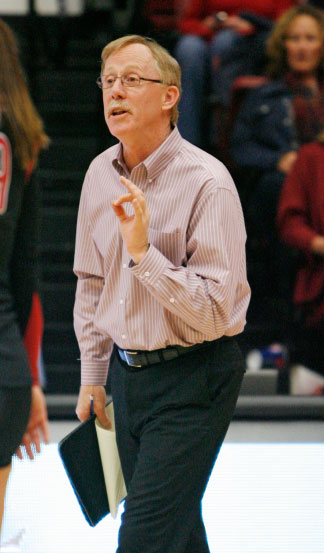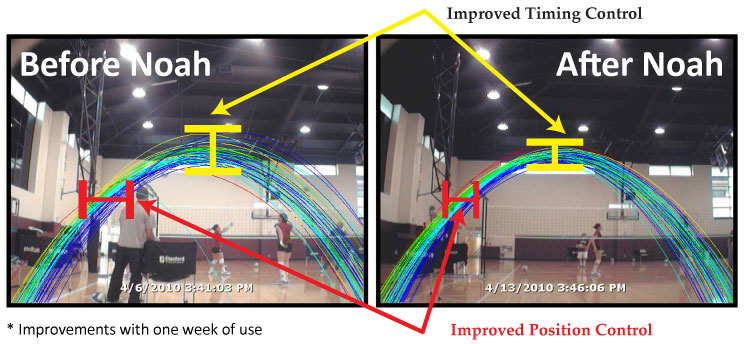JOHN DUNNING, HEAD COACH WOMEN’S VOLLEYBALL, STANFORD UNIVERSITY
ARTICLE ORIGINALLY APPEARED IN THE DECEMBER/JANUARY
2010 ISSUE OF AVCA’S COACHING VOLLEYBALL MAGAZINE
| Printer Friendly Version |
 In recent years my search for ways to help our team achieve the goals we have set, as well as for each player to have the chance to achieve the personal goals they have set for themselves, has expanded and intensified. I have always been curious and have attempted to be open to the thoughts of others in this search, but I have also allowed myself to be held back because of a strong belief in the things I had felt were the basis of my success as a coach.
The path we follow in our coaching life always presents us with opportunities to evolve. It is up to me to recognize these opportunities when they come along and actually listen; to read that book someone told me about, or call a coach to find out just what it is they are doing that is both different and effective.
In recent years my search for ways to help our team achieve the goals we have set, as well as for each player to have the chance to achieve the personal goals they have set for themselves, has expanded and intensified. I have always been curious and have attempted to be open to the thoughts of others in this search, but I have also allowed myself to be held back because of a strong belief in the things I had felt were the basis of my success as a coach.
The path we follow in our coaching life always presents us with opportunities to evolve. It is up to me to recognize these opportunities when they come along and actually listen; to read that book someone told me about, or call a coach to find out just what it is they are doing that is both different and effective.
Technology now exists in golf that enables increased expectations for performance levels in the area of consistency. They have the ability to track swing plane, ball flight, equipment performance, all of which enable the player to improve their ability to reproduce consistent shots.
In the sport of basketball, a trajectory training system called Noah is being used to help athletes obtain information about the arc of their shots and the exact location of their shots as they enter the basket. Noah gives instantaneous verbal and visual feedback about each shot; it stores and makes data accessible for each workout, and it rates each workout. This training technology has two major effects. First, verbal feedback comes from a source other than a coach. This helps prevent disagreement and fosters a positive learning environment. Second, over time, the expectations for performance levels can steadily rise. A free throw shooter can find an ideal shooting arc, and the feedback on each shot has a dramatic effect on the athlete’s dedication to raising their level of consistency of performance.
We have had the good fortune of observing the Stanford men’s basketball team using Noah in our shared practice facility. For the past ten months we have experimented with Noah training applications to the sport of volleyball. We set Noah up twenty feet behind the court, perpendicular to the flight of a set. Noah gives feedback on the arc of the set and the exact location of the set as it enters the hitting area. We can program the system to visually show each set or all sets on the computer screen, to print out each set or the entire session, and to rate the consistency of performance.
Initially, the exciting part of discovering Noah was that I was not the person providing the information on each play. We quickly found, though, that the athletes were excited to receive the information from Noah too, and that was of utmost importance to me. It put a smile on my face to have our setter set a Hut, hear Noah in the background say the set is 3 inches too low, and then see the setter try to make a better set on the next play.
For years, I caught every set during workouts and tried to give consistent feedback, only to learn that the setters thought I was very critical of them and that they believed the sets were the correct height regardless of what they were being told. Then I moved on to using a Catch-it with a four foot wide mouth to catch the sets and also establish a level of expectation for accuracy. We thought our setters were very accurate if they made ten in a row. To increase the challenge, half of the mouth of the Catch-it was covered to make the target smaller. Tears flowed and frowns grew until the setters improved and were accurate enough to consistently hit the new target. The next generation of training equipment was the Setting Eye, which has a significantly smaller target. We were finally getting somewhere in training setter accuracy, only the referees wouldn’t let the Eye on the court during competition. Practice had to include repetition without the Eye so that our accuracy would not drop when the Eye isn’t the target. We also needed a means of providing accurate feedback during competition conditions. Noah has provided that. We can set Noah up to give instant feedback during actual scrimmages.
No doubt we will look back in a few years and realize that our initial use of this new technology seemed like a big leap forward, but was actually just a glimpse through a door that is only slightly open. Every volleyball program that uses this technology will reap significant dividends with their setters. At the high school and club levels there is the possibility of an even greater impact. Perhaps the next step is to see how we can use Noah to give us information on the arc and location of all of our passes or digs. If players receive information about the height of each dig, after a period of time they will work toward repeating the desired height. It would not take long to see a drastic improvement in the consistency of performance. If we could add that consistency to our ball control, how long would it take for the timing of what we do offensively to improve?
As we all make choices about how to play the game, we base these choices on what we feel we know are “Truths of the Game,” the idea that certain performance levels cannot be surpassed. The discovery of Noah has made me look around at the worlds of golf, basketball, and tennis, and spurred me to think that the levels of performance we have accepted for so long may soon be changing. How accurate will the most accurate setter be in the near future, the most consistent passer?
I am certain our setters benefit each day that we use Noah, and that their improved accuracy will make our team better. But, for me there is something more important than that. When I toss a ball to a setter, who sets a ball into the Eye and Noah says, “47”, she knows it is a perfect set. When I toss her the next ball and the response is “45”, she knows the set is 6 inches too low. I know she will try to correct that next set by 6 inches. I have seldom experienced that level of dedication to performance. Hearing Noah’s feedback just compels my players to try for perfection. How good can we become if we continue to find new ways to raise the level of our performance expectations?


